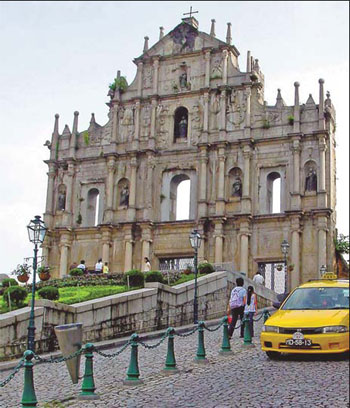Gambling capital is also gourmand's paradise
|
|
|
The ruins of the Church of St Paul's, built in 1602, is a fine example of Macao's cultural heritage. Wu Hede / Asia News photo |
Mention Macao and what comes to mind are magnificent hotels, glitzy nightclubs and packed casinos.
But there is another side to this city, one that is steeped in the rich and colorful history of a trading outpost that gave Western culture an early toehold in the East.
Much of this early European influence remains in the cobblestone alleyways, the colonial mansions and the many street-side cafes that recall the leisurely days of a previous era.
Situated at the mouth of a Pearl River estuary, Macao, with a total area of 29.2 sq km including the outlying islands of Taipa and Coloane, and Cotai, has been a place where East meets West for more than four centuries.
More than 90 percent of Macao's population of 542,000 are ethnic Chinese from the towns and villages of neighboring Guangdong province. The rest comprise mainly Portuguese and immigrants from other Asian countries.
Before the territory became a Portuguese colony in 1513, it was known by its Chinese name Ao Mun. The name Macao was derived from the Chinese A-Ma-Gao Bay. A-Ma was the name of the Chinese patron saint of seafarers and fishermen.
Macao was returned to China in 1999 and is now a special administrative region with an economy firmly rooted in tourism. It is now a favored destination of mainland tourists who come to shop, eat and, of course, gamble.
Begin your exploration of the hidden charms of Macao from A-Ma Temple, whose history goes back more than 500 years. The temple comprises prayer halls, pavilions and courtyards, built into the rock-strewn hill and connected by winding paths through moon gates and tiny gardens.
At the entrance of the temple is a large rock on which a traditional sailing junk was etched more than 400 years ago. On other rocks you can see red carved characters invoking divine blessings.
Your next stop should be the iconic ruins of the Church of St Paul's, built in 1602, next to the Jesuit College of St Paul's, the first Western college in Asia. In 1835, a fire razed both the college and the church, leaving only the magnificent facade of four colonnaded tiers, complete with carvings and statues.
Today, many music performances are held at this site; its dramatic setting being a natural stage. Within the precincts of the ruins of St Paul's lies the Museum of Sacred Art and Crypt. On display are religious paintings, statues and sacred objects from Macao's churches.
Senado Square is located in the heart of the city and is paved with a Portuguese-style wave-patterned mosaic of colored cobbled stones. One of Macao's most popular places to hang out, it is often the venue for all sorts of cultural events, especially during Chinese New Year, the Mid-Autumn Festival and Christmas.
Macao is also a paradise for gourmands. There are many restaurants offering a range of cuisine - from Chinese to Portuguese, Vietnamese to American and African.
Caf Litoral is highly recommended as it serves one of the city's best Portuguese-Macao dishes, and its traditional Portuguese-style decor, makes it look like a cozy cabin.
You can try Caldo Verde (green vegetable soup), and ameijoas (clams) for starters along with chourico (Portuguese sausage) and olives. Sardines are especially tasty during the summer.
Like all Portuguese restaurants, Caf Litoral also serves Portugal's codfish, prepared in a variety of ways - with egg and onions, creamed or grilled.
The most popular desserts in Macao are Portuguese egg pudding, chocolate mousse, and biscuit mousse. While Portuguese egg tarts can be found across China, there's nothing like trying it in the place of their origin.
The egg tarts at the Patisserie of Grand Hyatt Macao is a rare treat, as well as its French chef's European pastries, cakes and homemade chocolates.
Located in the City of Dreams aquatic entertainment resort on Cotai, Grand Hyatt Macau is an ideal place to recuperate after a full day of exploring the territory.
The City of Dreams is set to become a "must-do" on Macao travelers' itineraries. It brings together a "dream team" of global brands, such as Crown, Grand Haytt, Hard Rock Caf and Dragone to create an exceptional entertainment experience, appealing to the broadest spectrum of visitors from Asia and around the world.
 0
0 








